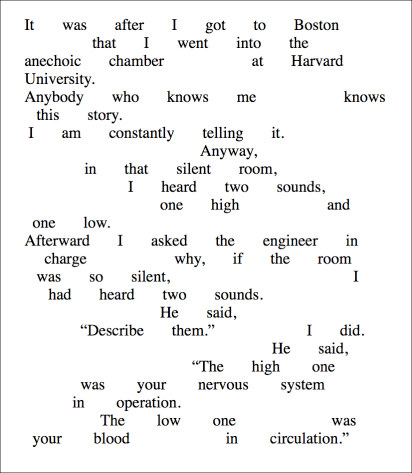Yesterday the day began with this advice from Kate:
And support your local bookstore
What actually matters to me includes thinking things through and constructing summaries of the process, perhaps for an audience of one. The blog is a basically harmless venue for such maunderings, and has the advantage of being distributable to any like-minded others out there. So things like this have a home where they can be found again at need:
Wovon man nicht sprechen kann
darüber muß man schweigen
Whereof one cannot speak
Thereof one must remain silent
…which has, among other things, to do with Silence, investigation of which has occupied me for the last couple of days. The subject came up via an eloquent post by Andy Ilachinski, which mentions “the infinite variety of silences that permeate existence” and references Notes on Silence and the accompanying film In Pursuit of Silence. I got and inhaled both.
And so I’ve spent the last couple of days bouncing around in various texts. Herewith some of my findings, each worth lingering over:
SILENCE and LICENSE are anagrams; both are forms of Freedom.
***
People think that their experiences are the reality and in fact, experiences are always interpretation, they’re always a construct. (Ross NS 264)
“Sound imposes a narrative on you and it’s always someone else’s narrative. My experience of silence was like being awake inside a dream I could direct.” (Maria Popova)
***
Any musician will tell you that the most important part of playing a piece of music, especially classical music, is the rests, the silences. (NS 276)
Louis Armstrong maintained that the important notes were the ones he didn’t play. (Popova)
***
“you are confronted with your inner noise, with your inner resistances.” (Sturtewagen NS 161)
“…persistent self-noise of the internal sort… ‘the interminable fizz of anxious thoughts or the self-regarding monologue’.” (Shen NS 207)
***
“I think it’s hard for us in the West to see silence as an end in itself… We think of silence as an absence and something negative…
Silence is like a rest in a piece of music—it’s not blank space, it’s a concrete space that’s filled with something other than words. (Pico Iyer NS 123)
***
“…as simple as shifting your attention from the things that cause noise in your life to the vast interior spaciousness which is our natural silence… the process of ungrasping, the process of opening your hand, of unclenching the fist…” (Ross IPS)
***
In a world of movement, stillness has become the great luxury. And in the world of distraction, it’s attention we’re hungering for. And in a world of noise silence calls us like a beautiful piece of music on the far side of the mountains. (Pico Iyer, IPS)
***
“Silence is a sound, a sound with many qualities… Silence is one of the loudest sounds and the heaviest sounds that you’re ever likely to hear.” (Evelyn Glennie)
***
“Modern people don’t feel moved or impressed just by living. In order to do so, we need to keep the silence and examine ourselves.” (Roshi Gensho Hozumi IPS)
Give up haste and activity. Close your mouth. Only then will you comprehend the spirit of Tâo. (Lao-tzu)
I also took this opportunity to reacquaint myself with R. Murray Schafer’s The Tuning of the World (“a pioneering exploration into the past history and present state of the most neglected aspect of our environment: the SOUNDSCAPE”), and to put my perceptual apparatus to work on the soundscape of a 4-mile trash picking up expedition. The sound of car and truck tires on the road was the loudest, most frequent, but still intermittent interruptor of silence; dogs barked at my passing in four places. My own footfalls were the regular punctuation of an otherwise almost entirely silent passage.
Schafer’s chapter on Silence provoked a brief dip into acoustical theory via Hermann von Helmholtz (1821-1894), whose On the Sensations of Tone as a Physiological Basis for the Theory of Music is a still-relevant exploration of the psychophysics of sound. von Helmholtz distinguished ‘non-periodic vibrations’ as “noise”, distinct from the ‘periodic vibrations’ that characterize music. Others (among them Claude Shannon) developed the notion of signal-to-noise ratio as a measure of the operational health of an information system. Noise is generally formless, seems to carry very little information, is inclined to the random rather than the patterned, and is that which we try to edit out of soundscapes as we pass through them. Anechoic chambers are sound environments that reduce noise to a minimum. John Cage’s description of his experience in such a space

Evelyn Glennie is another wonderful and inspiring re-discovery in the context of silence:
And here’s one of my favorite African music examples, a percussionist’s dream captured as University of Ghana postal workers cancelled stamps.
so…this is Goldie Hawn as well??
(Looks like her but I cannot see a list
of guests.)
Rachel